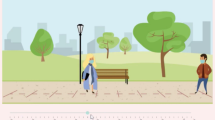Abstract
Cellular Automata have successfully been applied to the modeling and simulation of pedestrian dynamics. These simulations have often been focused on the evaluation of situations of medium-high density, in which the motivation of pedestrians overcomes natural proxemic tendencies. The COVID-19 outbreak has shown that in certain situations it is instead crucial to focus on situations in which proxemic is amplified by the particular affective state of the individuals involved in the studied scenario. We present the first steps in a research effort aimed at integrating results of quantitative analyses concerning effects of affective states on the perception of mutual distances by pedestrians of different type and the modeling of movement choices in a cellular automata framework.
Access this chapter
Tax calculation will be finalised at checkout
Purchases are for personal use only
Similar content being viewed by others
Notes
- 1.
We think it is relevant to mention the precise period since the perception of COVID-related risk changed significantly according to trend in the number of infections.
References
Bandini, S., Crociani, L., Gorrini, A., Nishinari, K., Vizzari, G.: Unveiling the hidden dimension of pedestrian crowds: introducing personal space and crowding into simulations. Fund. Inform. 171(1–4), 19–38 (2020)
Burstedde, C., Klauck, K., Schadschneider, A., Zittartz, J.: Simulation of pedestrian dynamics using a two-dimensional cellular automaton. Physica A 295(3–4), 507–525 (2001)
De Raad, B.: The Big Five Personality Factors: The Psycholexical Approach to Personality. Hogrefe & Huber Publishers, Kirkland (2000)
Dosey, M.A., Meisels, M.: Personal space and self-protection. J. Pers. Soc. Psychol. 11(2), 93 (1969)
Ekman, P.: An argument for basic emotions. Cogn. Emot. 6(3–4), 169–200 (1992)
Gasparini, F., Giltri, M., Briola, D., Dennunzio, A., Bandini, S.: Affectivity and proxemic distances: an experimental agent-based modeling approach. In: Proceedings of the Italian Workshop on Artificial Intelligence for an Ageing Society 2021, vol. 3108, pp. 81–92. AIxIA, CEUR Workshop Proceedings (2021)
Gorrini, A., Vizzari, G., Bandini, S.: Age and group-driven pedestrian behaviour: from observations to simulations. Collective Dyn. 1, 1–16 (2016)
Hall, E.T.: The Hidden Dimension, vol. 609. Doubleday, Garden City (1966)
Kirchner, A., Nishinari, K., Schadschneider, A.: Friction effects and clogging in a cellular automaton model for pedestrian dynamics. Phys. Rev. E 67, 056122 (2003)
Li, X., Guo, F., Kuang, H., Zhou, H.: Effect of psychological tension on pedestrian counter flow via an extended cost potential field cellular automaton model. Physica A 487, 47–57 (2017)
Ortony, A., Clore, G.L., Collins, A.: The Cognitive Structure of Emotions. Cambridge University Press, Cambridge (1990)
Saifi, L., Boubetra, A., Nouioua, F.: An approach for emotions and behavior modeling in a crowd in the presence of rare events. Adapt. Behav. 24(6), 428–445 (2016)
Wang, G.N., Chen, T., Chen, J.W., Deng, K., Wang, R.D.: Simulation study of crowd dynamics in pedestrian evacuation concerning panic contagion: a cellular automaton approach. Chinese Phys. B (2022)
Wąs, J., Gudowski, B., Matuszyk, P.J.: Social distances model of pedestrian dynamics. In: El Yacoubi, S., Chopard, B., Bandini, S. (eds.) ACRI 2006. LNCS, vol. 4173, pp. 492–501. Springer, Heidelberg (2006). https://doi.org/10.1007/11861201_57
Wilensky, U.: NetLogo. Center for Connected Learning and Computer-Based Modeling, Northwestern University, Evanston, IL (1999). http://ccl.northwestern.edu/netlogo/
Acknowledgments
This research is partially supported by Fondazione Cariplo, for the project LONGEVICITY - Social Inclusion for the Elderly through Walkability (Ref. 2017-0938).
Author information
Authors and Affiliations
Corresponding author
Editor information
Editors and Affiliations
Rights and permissions
Copyright information
© 2022 The Author(s), under exclusive license to Springer Nature Switzerland AG
About this paper
Cite this paper
Bandini, S., Briola, D., Dennunzio, A., Gasparini, F., Giltri, M., Vizzari, G. (2022). Integrating the Implications of Distance-Based Affective States in Cellular Automata Pedestrian Simulation. In: Chopard, B., Bandini, S., Dennunzio, A., Arabi Haddad, M. (eds) Cellular Automata. ACRI 2022. Lecture Notes in Computer Science, vol 13402. Springer, Cham. https://doi.org/10.1007/978-3-031-14926-9_23
Download citation
DOI: https://doi.org/10.1007/978-3-031-14926-9_23
Published:
Publisher Name: Springer, Cham
Print ISBN: 978-3-031-14925-2
Online ISBN: 978-3-031-14926-9
eBook Packages: Computer ScienceComputer Science (R0)




